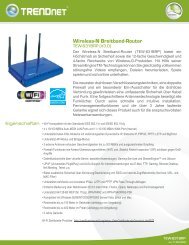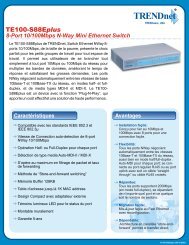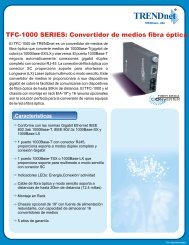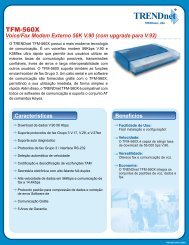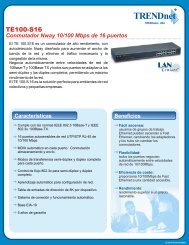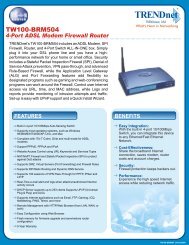Create successful ePaper yourself
Turn your PDF publications into a flip-book with our unique Google optimized e-Paper software.
<strong>Wi</strong>reless Antennas enable wireless networks to reach farther distances and deliver high performance in a concentrated<br />
area. They can efficiently expand a network's coverage area to include indoor areas spread out on different floors to an<br />
outdoor scenario that spans from building to building.<br />
TEW-AI75OB<br />
<strong>Wi</strong>-<strong>Fi</strong> Standards and Benefits<br />
Reduces interference in high traffic areas<br />
Expands wireless coverage area<br />
Built for durable indoor/outdoor placement<br />
Includes wall/ceiling or pole mount<br />
IEEE 802.11 is an IEEE (Institute of Electrical and Electronic Engineers) standard that specifies wireless communications via<br />
2.4GHz at speeds of 1<br />
~<br />
2Mbps. This standard was ratified in 1997 with the release of several different wireless products,<br />
but it wasn't until IEEE 802.11b came that the people started to see the benefits of wireless technology.<br />
IEEE 802.11n draft is an approved draft specification for the upcoming 802.11n standard, which is scheduled to be ratified in<br />
2007. <strong>Wi</strong>th 300Mbps of speed coupled with MIMO antenna technology, 802.11n is a major throughput and range upgrade to<br />
802.11g. As the new wireless area network standard, its purpose is to simultaneously deliver bandwidth intensive files, like<br />
HD streaming and online gaming, to multiple users, while maintaining speed integrity over a wider coverage area.<br />
IEEE 802.11b was ratified in 1999 and produced the speed required for efficient wireless Internet access. <strong>Wi</strong>th its 11Mbps<br />
speed enhancement and larger wireless coverage the wireless era began. It is the most widely adopted and available <strong>Wi</strong>-<strong>Fi</strong><br />
standard in the market today.<br />
IEEE 802.11g was ratified in 2003 but was widely adopted before standardization. Some larger corporations like Cisco held<br />
off with product releases until standardization was complete. 802.11g now boosts wireless speeds to 54Mbps enabling<br />
faster file sharing and more efficient wireless communications.<br />
IEEE 802.11a was ratified in 1999 but products weren't seen until 2001. 802.11a was the first wireless technology that<br />
featured 54Mbps of throughput. Instead of the 2.4GHz frequency, 802.11a used the 5GHz frequency band to avoid<br />
interference with the numerous amounts of 2.4GHz devices that overpopulated the market. At first release, 802.11a<br />
showed minimal success due to the short range of coverage and international regulations, but in response, the wireless<br />
industry improved on the technology until it held performance characteristics more related to 802.11b.<br />
v2.0906<br />
<strong>TRENDnet</strong> <strong>Wi</strong>-<strong>Fi</strong> <strong>Tutorial</strong> 3



